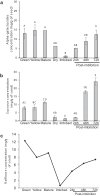Spatial regulation of alpha-galactosidase activity and its influence on raffinose family oligosaccharides during seed maturation and germination in Cicer arietinum
- PMID: 31906799
- PMCID: PMC8570745
- DOI: 10.1080/15592324.2019.1709707
Spatial regulation of alpha-galactosidase activity and its influence on raffinose family oligosaccharides during seed maturation and germination in Cicer arietinum
Abstract
Alpha-galactosides or Raffinose Family Oligosaccharides (RFOs) are enriched in legumes and are considered as anti-nutritional factors responsible for inducing flatulence. Due to a lack of alpha-galactosidases in the stomachs of humans and other monogastric animals, these RFOs are not metabolized and are passed to the intestines to be processed by gut bacteria leading to distressing flatulence. In plants, alpha(α)-galactosides are involved in desiccation tolerance during seed maturation and act as a source of stored energy utilized by germinating seeds. The hydrolytic enzyme alpha-galactosidase (α-GAL) can break down RFOs into sucrose and galactose releasing the monosaccharide α-galactose back into the system. Through characterization of RFOs, sucrose, reducing sugars, and α-GAL activity in maturing and germinating chickpeas, we show that stored RFOs are likely required to maintain a steady-state level of reducing sugars. These reducing sugars can then be readily converted to generate energy required for the high energy-demanding germination process. Our observations indicate that RFO levels are lowest in imbibed seeds and rapidly increase post-imbibition. Both RFOs and the α-GAL activity are possibly required to maintain a steady-state level of the reducing monosaccharide sugars, starting from dry seeds all the way through post-germination, to provide the energy for increased germination vigor.
Keywords: Alpha-galactosidase; RFO; Reducing sugar; Sucrose; chickpea; flatulence; raffinose.
Figures






References
-
- Muzquiz M, Burbano C, Pedrosa MM, Folkman W, Gulewicz K.. Lupins as a potential source of raffinose family oligosaccharides: preparative method for their isolation and purification. Ind Crops Prod. 1999;9:1–7. doi:10.1016/S0926-6690(98)00030-2. - DOI
-
- Peterbauer T, Richter A.. Biochemistry and physiology of raffinose family oligosaccharides and galactosyl cyclitols in seeds. Seed Sci Res. 2001;11:185–197.
-
- Salunkhe DK. Legumes in human nutrition: current status and future research needs. Curr Sci. 1982;51:387–394.
-
- Rackis JJ. Oligosaccharides of food legumes: alpha-galactosidase activity and the flatus problem. ACS Symp Ser Amer Chem Soc. 1975;15:207–222.
-
- Blackig M, Corbineau F, Grzesikit M, Guyi P, Côme D. Carbohydrate metabolism in the developing and maturing wheat embryo in relation to its desiccation tolerance. J Exp Bot. 1996;47:161–169.
Publication types
MeSH terms
Substances
LinkOut - more resources
Full Text Sources
Other Literature Sources
